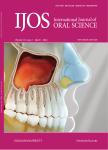PiggyBac transposon-mediated gene delivery efficiently generates stable transfectants derived from cultured primary human deciduous tooth dental pulp cells(HDDPCs) and HDDPC-derived iPS cells
PiggyBac transposon-mediated gene delivery efficiently generates stable transfectants derived from cultured primary human deciduous tooth dental pulp cells(HDDPCs) and HDDPC-derived iPS cells作者机构:Department of Pediatric Dentistry Kagoshima University Graduate School of Medical and Dental Sciences Division of Pediatric Dentistry Graduate School of Medical and Dental Science Niigata University Animal Genome Research Unit Division of Animal Science National Institute of Agrobiological Sciences Functional Biomolecules Research Group National Agriculture and Food Research Organization Division of Basic Molecular Science and Molecular Medicine School of Medicine Tokai University Section of Gene Expression Regulation Frontier Science Research Center Kagoshima University
出 版 物:《International Journal of Oral Science》 (国际口腔科学杂志(英文版))
年 卷 期:2015年第7卷第3期
页 面:144-154页
核心收录:
学科分类:1003[医学-口腔医学] 1001[医学-基础医学(可授医学、理学学位)] 100101[医学-人体解剖与组织胚胎学] 10[医学]
基 金:supported in part by a Grant-in-Aid for Scientific Research (C) (grant no. 25463192) from the Ministry of Education Science Sports Culture and Technology of Japan
主 题:drug selection electroporation genetically modified human deciduous tooth dental pulp cells Piggy Bac
摘 要:The ability of human deciduous tooth dental pulp cells(HDDPCs) to differentiate into odontoblasts that generate mineralized tissue holds immense potential for therapeutic use in the field of tooth regenerative medicine. Realization of this potential depends on efficient and optimized protocols for the genetic manipulation of HDDPCs. In this study, we demonstrate the use of a Piggy Bac(PB)-based gene transfer system as a method for introducing nonviral transposon DNA into HDDPCs and HDDPC-derived inducible pluripotent stem cells. The transfection efficiency of the PB-based system was significantly greater than previously reported for electroporation-based transfection of plasmid DNA. Using the neomycin resistance gene as a selection marker, HDDPCs were stably transfected at a rate nearly 40-fold higher than that achieved using conventional methods. Using this system, it was also possible to introduce two constructs simultaneously into a single cell. The resulting stable transfectants, expressing td Tomato and enhanced green fluorescent protein, exhibited both red and green fluorescence. The established cell line did not lose the acquired phenotype over three months of culture. Based on our results, we concluded that PB is superior to currently available methods for introducing plasmid DNA into HDDPCs. There may be significant challenges in the direct clinical application of this method for human dental tissue engineering due to safety risks and ethical concerns. However, the high level of transfection achieved with PB may have significant advantages in basic scientific research for dental tissue engineering applications, such as functional studies of genes and proteins. Furthermore, it is a useful tool for the isolation of genetically engineered HDDPC-derived stem cells for studies in tooth regenerative medicine.



